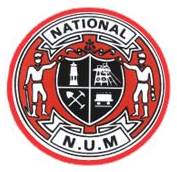
The Transport and General Workers' Union was one of the largest general trade unions in the United Kingdom and Ireland – where it was known as the Amalgamated Transport and General Workers' Union (ATGWU) to differentiate itself from the Irish Transport and General Workers' Union – with 900,000 members. It was founded in 1922 and Ernest Bevin served as its first general secretary.

The National Union of Mineworkers (NUM) is a trade union for coal miners in Great Britain, formed in 1945 from the Miners' Federation of Great Britain (MFGB). The NUM took part in three national miners' strikes, in 1972, 1974 and 1984–85. After the 1984–85 strike and the subsequent closure of most of Britain's coal mines, it became a much smaller union. It had around 170,000 members when Arthur Scargill became leader in 1981, a figure which had fallen in 2015 to an active membership of around 100.
The Dock, Wharf, Riverside and General Labourers Union (DWRGLU), often known as the Dockers' Union, was a British trade union representing dock workers in the United Kingdom.
The National Union of Dock Labourers (NUDL) was a trade union in the United Kingdom which existed between 1889 and 1922.
The Miners' Federation of Great Britain (MFGB) was established after a meeting of local mining trade unions in Newport, Wales in 1888. The federation was formed to represent and co-ordinate the affairs of local and regional miners' unions in England, Scotland and Wales whose associations remained largely autonomous. At its peak, the federation represented nearly one million workers. It was reorganised into the National Union of Mineworkers in 1945.
The National Amalgamated Union of Labour (NAUL) was a general union in the United Kingdom.

The National Union of Scottish Mineworkers (NUSW) is a trade union in Scotland, founded in 1894 as the Scottish Miners Federation. It joined the Miners' Federation of Great Britain, and in 1914 changed its name to National Union of Scottish Mineworkers. It survives as the National Union of Mineworkers.
The Lancashire and Cheshire Miners' Federation (LCMF) was a trade union that operated on the Lancashire Coalfield in North West England from 1881 until it became the Lancashire area of the National Union of Mineworkers in 1945.

The Durham Miners' Association (DMA) is a trade union in the United Kingdom.
The Northern Rhodesian African Mineworkers' Union (A.M.U.) was a trade union in Northern Rhodesia which represented black African miners in the Copperbelt. The AMU was formed in 1949, and campaigned actively to improve working conditions and wages for African miners, as well as opposing racial discrimination in hiring. The union amalgamated with several other mining unions in 1967 to form the Mineworkers' Union of Zambia.
The Cumberland Miners' Association was a trade union in the United Kingdom.
The Lanarkshire Miners' County Union, later the Lanarkshire Mineworkers' Union, represented coal miners in the Lanarkshire district of Scotland.
The North Wales Miners' Association was a trade union representing coal miners in Wales.
The Fife and Kinross Miners' Association was a coal miners' trade union based in Fife and Kinross-shire in Scotland.
The Mid and West Lothian Labour Federation was a trade union representing coal and shale miners in the West Lothian area of Scotland.
The Warwickshire Miners' Association was a trade union representing coal miners in the Warwickshire area of England.
The Durham Colliery Mechanics' Association was a trade union representing mechanics working at coal mines in County Durham, in England.
The Durham County Colliery Enginemen's Association was a trade union representing engine operators at coal mines in County Durham.
The National Federation of Colliery Officials was a trade union representing colliery workers in the United Kingdom who were not involved in manual labour.




